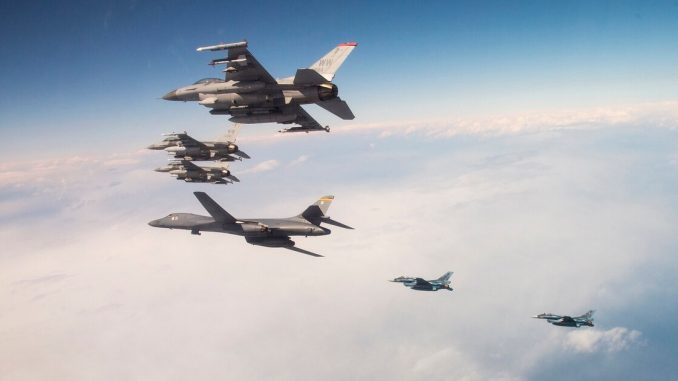
WASHINGTON and PORSTMOUTH, New Hampshire — Two of the Trump administration’s top national security officials have signaled in the last week that the NATO target of spending 2 percent of gross domestic product on defense is now the “gold standard” being applied to all allies around the globe.
While not a hard figure from the administration, the target may catch the attention of allies in the wake of years of comments from President Donald Trump that those nations are not spending enough on defense.
On Tuesday, Secretary of Defense Mark Esper appeared at the Atlantic Council. Buried in the middle of a wide-ranging speech, Esper said that the Trump administration urges “all member states to uphold their commitments and contribute more to our collective security. This goes beyond NATO as well. We expect all allies to invest more in defense, at least 2 percent of GDP, as the floor.”
“We also expect them to be ready, capable and willing to deploy when trouble calls, and we expect them to stand shoulder to shoulder with the United States in confronting Chinese bad behavior and Russian aggression,” Esper continued. “To overcome the increasingly complex threats in the 21st century and defend our shared values, there can be no free riders to our common security.”
Esper’s comments came several days after National Security Advisor Robert O’Brien indicated in an Oct. 16 speech that the U.S. views the 2 percent target as a “benchmark” for ally Taiwan to hit.
“They’ve upped their defense spending, I’m told now they’re getting closer to 2 percent which would be a NATO level — obviously Taiwan’s not part of NATO but that would be kind of a benchmark — and they probably need to go beyond that given the buildup of Chinese forces especially across the Taiwan Strait,” O’Brien said.
While traveling in New Hampshire Oct. 21, O’Brien responded to a question from Defense News, saying “What’s happened is a 2 percent has become the gold standard, and countries, even non-NATO countries, want to hit it.”
“I think we’ve really set a gold standard,” O’Brien said. “We made 2 percent the benchmark.”
During the 2014 Wales summit, NATO leaders agreed each nation would aim to spend 2 percent of its gross domestic product on defense by 2024. The measure was non-binding and even at the time there was widespread speculation that all allied nations could ever get there, but the agreement was seen as a symbolic show of unity in the immediate aftermath of Russia’s invasion of Ukrainian territory.
It was also a pledge that European officials, behind closed doors, now admit may have been a mistake. Early on in his first campaign, Trump focused in on the idea that NATO nations “owed” the U.S. money for not hitting the 2 percent target, and he has repeatedly railed against those nations who are not spending at that benchmark.
While experts argue that the focus on 2 percent is flawed — Greece, which annually clears that threshold, is often held up as an example, given that more than 75 percent of its defense spending goes to personnel or pension costs — it has proven to be a reliable talking point for administration officials.
Putting aside the NATO nations, some key defense allies and partners include:
- Australia (1.9 percent GDP on defense, per 2019 SIPRI figures)
- New Zealand (1.5 percent)
- Philippines (1 percent)
- Thailand (1.3 percent)
- Japan (0.9 percent)
- South Korea (2.7 percent)
- Taiwan (1.7 percent)
- Israel (5.3 percent)
A spokesman for Esper said the 2 percent as a target statement is one that has been conveyed to non-NATO allies during discussions this year, but some question whether the standard is one that makes sense outside of that particular alliance context.
Dustin Walker, a former staffer on the Senate Armed Services Committee who covered both European and Pacific issues, said that adopting the 2 percent target across the globe “would be a mistake.”
“Whatever one thinks about the merits of the 2 percent goal in a NATO context, it was the product of allied consultation and consensus at the Wales Summit in 2014. That is simply not the case when it comes to American allies and partners outside of NATO,” Walker noted. “And at the very least, it’s highly debatable that 2 percent is an appropriate standard to be applied rigidly across the globe regardless of strategic or economic circumstance.”
In New Hampshire, O’Brien acknowledged that the 2 percent figure comes with volatility.
“Look, COVID is taking a bite out of budgets, there’s no question about it,” he said, referring to the pandemic. “Interestingly, as the GDP contracts, there may be a couple of countries that hit 2 percent because their defense budgets stay relatively static, but their economies contract a little bit, so they may hit the 2 percent.
“That’s not what we’re looking for, we’re obviously looking for increased spending,” he added. “Obviously we want to see them increase expenditures. I don’t think there’s backsliding, I think there’s a commitment to it.”
Emma Ashford, a senior fellow at the Atlantic Council, warned that the 2 percent goal, with its focus on raw spending, largely misses the point of defense spending. But she notes it’s not surprising that the figure has become such a beacon in Washington.
“I do think it represents a broader shift in Washington towards considering how to push for greater burden-sharing by allies, and that’s a big change from pre-Trump, when it was considered bold to even suggest that increased burden-sharing might be necessary,” Ashford said.
“The fact that we’re now talking about potential ways to measure that — even these very imperfect ones — signals how far we’ve come on this question in four years.”


Be the first to comment